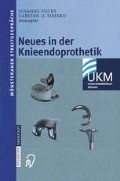Zusammenfassung
176 Patienten mit einer Kniegelenksarthrose wurden prospektiv randomisiert in zwei Gruppen eingeteilt. In beiden Gruppen wurde das hintere Kreuzband vom femoralen Ansatz abgelöst. In einer Gruppe wurde eine „posterior-stabilized“ Tibiakomponente benutzt, während in der anderen Gruppe ein „deep-dish“-Polyethyleninlay eingesetzt wurde (Genesis II). Die chirurgische und perioperative Technik war in beiden Gruppen identisch und alle Implantate wurden zementiert. Die Patienten begannen Übungen zur Verbesserung des Bewegungsumfanges in den ersten Stunden nach der Operation und die schmerzadaptierte Vollbelastung am ersten postoperativen Tag. Bei der Follow-up-Untersuchung zeigte sich kein signifikanter Unterschied in der durchschnittlichen Flexion (116º), der Fähigkeit, Treppen bipedal herauf-und herabzusteigen (80%), den Schmerz-Scores, den Knie-Scores (94), der Stabilität oder der Abwesenheit des anterioren Knieschmerzes. Die postoperative Implantatausrichtung in der sagittalen und koronaren Ebene, wie auch in den Patella-tangential-Aufnahmen, waren in beiden Gruppen ausgezeichnet. Bei nur einem einzigen Patienten in der „deep-dish“-Gruppe war ein laterales Release notwendig. Die Benutzung des „deep-dish“-Implantates vermeidet die Resektion des interkondylären, femoralen Knochens, verringert dadurch die Frakturgefahr und maximiert das Knochenvolumen für den Fall einer zukünftigen Wechseloperation.
Übersetzt aus dem Englischen von Dr. med. Carsten O. Tibesku
Access this chapter
Tax calculation will be finalised at checkout
Purchases are for personal use only
Preview
Unable to display preview. Download preview PDF.
Literatur
Andriacchi T, Galante JO (1998) Retention of the posterior cruciate ligament in total knee arthroplasty. J Arthroplasty 3:13–19.
Andriacchi T, Galante JO (1982) The influence of total knee replacement design on walking and stair climbing. J Bone Joint Surg 64A:1328–1334
Cobb AC, Ewald FC, Wright RJ, Sledge CB (1990) The kinematic knee: survivorship analysis of 1943 knees. J Bone Joint Surg 72B:542–546
Dennis D, Komistek R, Colwell C (1998) In vivo anteroposterior femorotibial translation of total knee arthroplasty: A multicenter analysis. Clin Orthop 356:4757
Diduch D, Insall JN, Scott WN, Scuderi GR (1997) Total knee replacement in young active patients: long term follow up and functional outcome. J Bone Joint Surg 79A:575–582
Dorr L, Ochsner J, Gronley J, Perry J (1988) Functional comparison of posterior cruciate retained versus sacrificed total knee arthroplasty. Clin Orthop 236:36–43
Ewald F (1989) The Knee Society total knee arthroplasty roentgenographic evaluation and scoring system. Cl Orthop 248:9–15
Font-Rodriguez DE, Insall JN (1997) Survivorship of cemented total knee arthroplasty. Clin Orthop 343:79–86
Freeman M, Railton G (1988) Should the posterior cruciate ligament be retained or resected in condylar nonmeniscal knee arthroplasty: The case for resection. J. Arthroplasty 3:3–12
Garino J, Lotke P (1994) Sacrifing the posterior cruciate ligament with and without substitution in total knee arthroplasty. In: Fu F, editor. Knee Surgery. Baltimore: Williams & Wilkins, pp 1321–1329
Haas SB, Nelson CL, Laskin RS (2000) Posterior stabilized knee arthroplasty: an assessment of bone resection. The Knee 7:25–30
Hofmann A, Pace T (1994) Cruciate ligament retentin in total knee arthroplasty. In: Fu F, editor. Knee Surgery. Baltimore: Williams & Wilkins, pp 1313–1320
Insall J, Ranawat CS, Agliette P, Shine J (1976) A comparison of four models of total knee replacement prosthesis. J Bone Joint Surg 58A:754–765
Insall J, Dorr L, Scott R, Scott W (1989) Rationale of the knee society clinical rating system. Clin Orthop 248:13–15
Insall J, Laschiewicz P, Burstein A (1982) The posterior stabilized condylar prosthesis: a modification of the total condylar design. J Bone Joint Surg 64A:1317–1323
Iorio R, Healey W, Kirven F, Patch D, Pfeifer B (1998) Knee implant standardization: an implant selection and cost reduction program. Am. J Knee Surg 10:73–79
Laskin R (1996) Total knee replacement with posterior cruciate ligament retention in patients with a fixed varus deformity. Clin Orthop 331:29–34
Laskin R (1989) The surgical technique for performing a total knee replacement arthroplasty. Ortho Clin NA 20:31–48
Laskin RS (1995) Flexion space configuration in total knee replacement. J Arthroplasty 10:657–661
Lombardi A, Mallory T, Eberle R (1994) Constrained knee arthroplasty. In: Fu F, (ed). Knee Surgery, Baltimore. Williams and Wilkins, pp 1331–1350
Lombardi A, Mallory T, Waterman R, Eberle R (1995) Intercondylar distal femoral fracture. J Arthroplasty 10:643–650
Paletta G, Laskin R (1996) Total condylar knee replacement in rheumatoid arthritis. J Bone Joint Surg 77A:42–49
Schultz RA, Miller DC, Kerr CS (1998) Mechanoreceptors in human cruciate ligaments. A histologic study. J Bone Joint Surg 80A:1072–1076
Scott R, Thornhill T (1994) Posterior cruciate supplementing total knee replacement using conforming inserts and cruciate recession. Clin Orthop 205:146–149.
Simmons S, Lephart S, Rubash H, Borsa P, Barrack R (1996) Proprioception following total knee arthroplasty with and without the posterior cruciate ligament. J Arthroplasty 11:763–768
Stiehl JB, Komistek RD, Dennis DA, Paxson RD (1998) Fluoroscopic analysis of kinematics after posterior cruciate retaining knee arthroplasty. J Bone Joint Surg 80A:884–889
Stiehl JB, Voorhorst PE, Keblish P, Sorrels RB (1997) Comparison of range of motion after posterior cruciate ligament retention or sacrifice with a mobile bearing total knee arthroplasty. Am J Knee Surg 10:216–220
Ware JE Jr, Sherbourne CD (1992) The MOS 36 item short form health survery (SF-36). Conceptual framework and item selection. Med Care 30:473–483
Warren PJ, Olanlokun TK (1994) Proprioception after total knee arthroplasty. The influence of prosthetic design. Clin Orthop 297:182–187
Windsor R, Insall JN, Vince KG (1988) Technical considerations of total knee arthroplasty after proximal tibial osteotomy. J Bone Joint Surg 70A:547–555.
Editor information
Editors and Affiliations
Rights and permissions
Copyright information
© 2003 Springer-Verlag Berlin Heidelberg
About this paper
Cite this paper
Laskin, R.S., Maruyama, Y., Villaneuva, M., Bourne, R. (2003). Die Verwendung von kongruenten Tibiakomponenten „deep dish“ in der Knieendoprothetik — eine randomisierte, prospektive Studie. In: Fuchs, S., Tibesku, C.O. (eds) Neues in der Knieendoprothetik. Münsteraner Streitgespräche. Steinkopff, Heidelberg. https://doi.org/10.1007/978-3-642-57368-2_13
Download citation
DOI: https://doi.org/10.1007/978-3-642-57368-2_13
Publisher Name: Steinkopff, Heidelberg
Print ISBN: 978-3-7985-1388-4
Online ISBN: 978-3-642-57368-2
eBook Packages: Springer Book Archive

